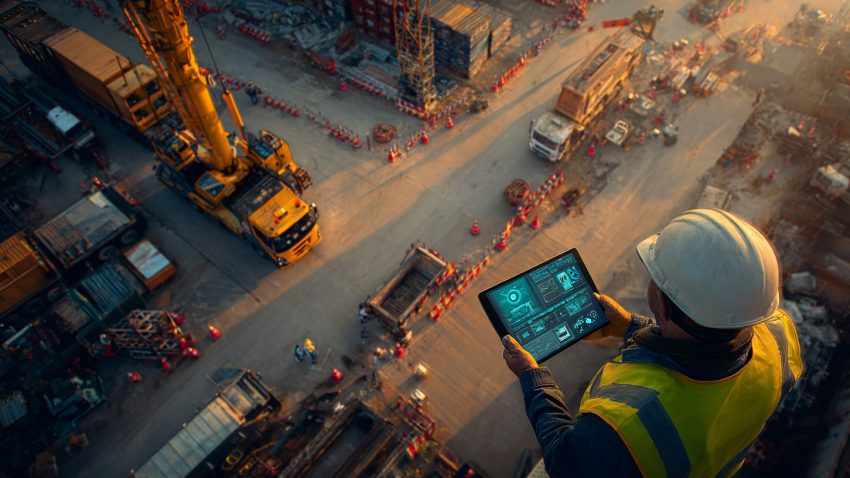Construction Automation: How AI, Robotics, and Construction Management Software Are Shaping the Future of Commercial Construction
Table of Contents:
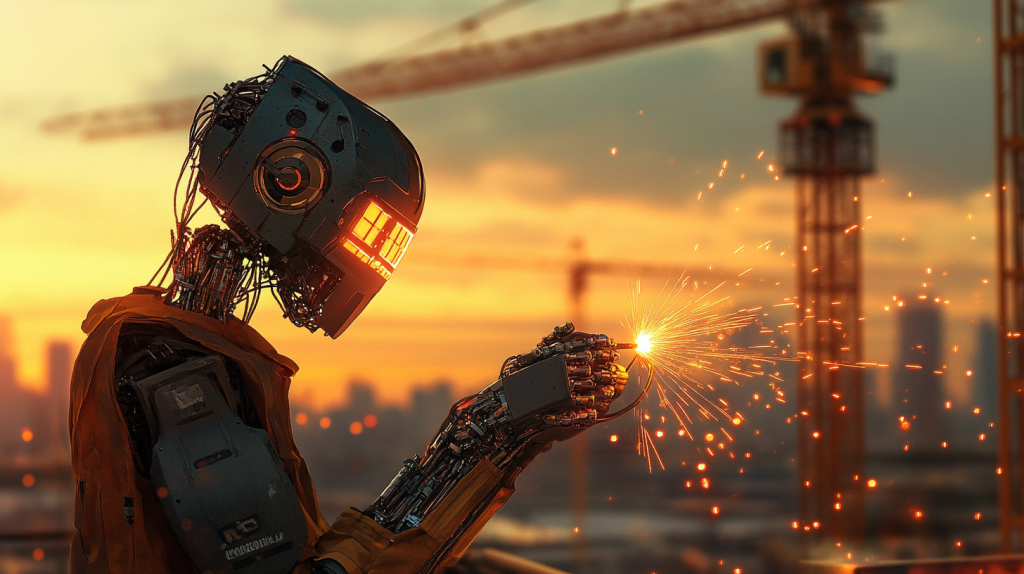
As the demand for efficiency and precision in commercial construction grows, construction automation is stepping up to the plate. The integration of AI, robotics, and advanced construction management software is transforming the industry, enabling faster, safer, and more cost-effective projects. These technologies streamline processes, improve resource allocation, and reduce human error—changing the way buildings are designed, built, and managed. In this guide, we’ll explore how construction automation is shaping the future, detailing key technologies, their benefits, and what the future holds for this rapidly evolving field.
What is Construction Automation?
Construction automation refers to the use of AI, robotics, and software tools to automate various aspects of the construction process. This could range from using robotics to lay bricks and pour concrete to employing AI-powered algorithms for project scheduling, material tracking, and predictive maintenance. Unlike traditional construction, which relies heavily on manual labor and experience, construction automation leverages data and machine precision to make operations smoother, faster, and safer.
Why is Construction Automation Gaining Popularity?
In the commercial construction sector, automation addresses several key challenges: labor shortages, increasing project complexity, rising costs, and the need for faster project delivery. By adopting automation, construction companies can fill labor gaps, cut down on operational costs, and ensure high-quality results—all while keeping up with tight project deadlines.
How AI is Transforming Construction Project Management
Artificial Intelligence (AI) is revolutionizing project management by using data-driven insights to predict outcomes, allocate resources, and manage risks more effectively. Let’s explore some of AI’s most impactful applications in construction project management.
AI-Powered Scheduling and Resource Allocation
AI-based scheduling tools can analyze vast amounts of data from past projects to predict optimal timelines, reduce bottlenecks, and improve resource allocation. By anticipating potential delays and resource constraints, AI helps project managers stay on track and avoid costly setbacks. For example, AI algorithms can predict how weather, supply chain disruptions, or labor availability might impact schedules, enabling teams to proactively adjust plans.
Predictive Maintenance and Equipment Monitoring
Construction projects rely heavily on machinery and equipment, and unexpected breakdowns can cause significant delays. AI-driven predictive maintenance tools monitor equipment health in real-time, using data to identify potential issues before they lead to failures. This proactive approach reduces downtime, lowers maintenance costs, and extends the lifespan of construction equipment.
AI-Enhanced Quality Control and Safety Monitoring
Quality and safety are paramount in commercial construction, and AI is playing a crucial role in both. AI-powered quality control tools analyze real-time data from cameras and sensors to spot errors or safety risks, such as improper PPE usage or structural issues. With AI’s ability to catch these issues early, project managers can ensure safety compliance and maintain high-quality standards without compromising on speed.
The Role of Robotics in Modern Commercial Construction
While AI helps with planning and oversight, robotics are taking over the hands-on tasks in construction. Robotics increase productivity and allow workers to focus on complex tasks that require human expertise, while machines handle the repetitive and high-risk jobs.
Autonomous Equipment for Heavy Lifting and Site Prep
Robots are increasingly used for heavy lifting, excavation, and other labor-intensive tasks. Autonomous equipment, such as robotic excavators and bulldozers, can perform these tasks without human intervention, reducing the physical strain on workers and speeding up the construction process. These machines use GPS and AI guidance to follow precise paths, ensuring that site prep is done accurately and efficiently.
Robotic Bricklaying and Concrete Pouring
Automated systems like robotic bricklayers and concrete pourers are making waves on construction sites. These robots can lay thousands of bricks or pour concrete slabs with greater precision and speed than manual labor, cutting down project timelines and reducing material waste. Robotic bricklayers, for example, can place bricks with millimeter accuracy, ensuring structural integrity and reducing the need for rework.
Drones for Site Inspection and Surveying
Drones equipped with cameras and AI software are now a standard tool for surveying, site inspection, and progress tracking. These drones provide real-time aerial views, allowing project managers to monitor work from a safe distance. Drones can also capture detailed data on site conditions, which can then be analyzed by AI algorithms to assess progress, identify risks, and ensure compliance.
How Construction Management Software Complements AI and Robotics

Construction management software acts as the backbone of automation by integrating AI and robotics into a cohesive workflow. From project tracking to document management, construction management software brings data, people, and machines together on a single platform, ensuring seamless collaboration and oversight.
Project Scheduling and Task Automation
Construction management software streamlines project scheduling by automating task assignments, resource allocation, and timelines. Integrating AI into the software allows for predictive scheduling, where adjustments can be made in real time based on project demands or unforeseen delays. This prevents bottlenecks and ensures that tasks are completed in the most efficient sequence.
Document Control and Compliance Tracking
Commercial construction projects generate a mountain of documentation, from blueprints and contracts to safety reports and inspection logs. Construction management software simplifies document control by creating a centralized, digital repository. This ensures that all stakeholders have access to the latest documents, reducing errors and improving compliance with safety and regulatory standards.
Real-Time Communication and Collaboration
One of the greatest advantages of construction management software is real-time communication. With cloud-based platforms, team members can access project data and communicate instantly, no matter where they are. This seamless collaboration is particularly valuable on complex commercial projects, where multiple teams need to stay aligned to maintain workflow efficiency.
Key Benefits of Construction Automation in Commercial Projects
Automation in commercial construction offers a host of benefits that directly impact the bottom line, as well as project quality and safety. Here’s a closer look at the core benefits of automation:
1. Boosted Productivity and Reduced Labor Demand
By automating repetitive and labor-intensive tasks, construction companies can achieve higher productivity with fewer workers. This is particularly valuable given the current labor shortages in the construction industry.
2. Improved Safety and Risk Management
With robots handling hazardous tasks and AI monitoring safety protocols, automation reduces the risk of accidents on construction sites. Automated safety checks and real-time alerts help project managers maintain a safe work environment for all team members.
3. Enhanced Precision and Quality Control
AI-driven quality control systems can analyze construction in real-time, identifying errors and ensuring that projects meet high standards. Robotic precision also minimizes human error, leading to fewer reworks and higher-quality outcomes.
4. Optimized Project Timelines
Automation keeps projects on track by reducing downtime, minimizing delays, and ensuring that resources are used efficiently. With AI-powered scheduling and robotics handling repetitive tasks, construction timelines become more predictable and manageable.
5. Cost Savings Through Efficiency
With faster project timelines, optimized resource use, and fewer errors, automation leads to significant cost savings. Predictive maintenance, quality control, and reduced material waste further contribute to the financial benefits of construction automation.
Best Practices for Implementing Automation in Commercial Construction
To maximize the benefits of automation, it’s important to approach implementation with a clear strategy. Here are some best practices to consider:
1. Start Small and Build Gradually
Begin by automating smaller tasks or specific project phases before scaling up. For instance, you might start with drones for site inspections before investing in robotic bricklayers. This approach allows you to evaluate the impact and refine your strategy over time.
2. Invest in Training and Change Management
Introducing automation requires a shift in workflow, so it’s essential to train team members on how to use new tools effectively. Change management practices can help ease the transition, ensuring that employees understand the benefits of automation and feel comfortable with the technology.
3. Collaborate with Automation Specialists
Working with vendors or consultants who specialize in construction automation will streamline the implementation process. These experts can provide guidance on selecting the right tools, integrating them into your workflow, and troubleshooting any issues that arise.
4. Prioritize Data Security and Compliance
Automation involves a significant amount of data collection, so it’s important to prioritize data security and compliance. Use secure software solutions and establish clear data governance policies to protect sensitive project information and comply with industry regulations.
The Future of Automation in Commercial Construction
As technology advances, construction automation will continue to evolve, offering even more innovative solutions for commercial construction projects. Here are some trends to watch for in the coming years:
Fully Autonomous Construction Sites
Fully autonomous job sites, where AI and robotics handle nearly all aspects of construction, are no longer just a vision of the future. Companies are experimenting with fully autonomous machines for earthmoving, site prep, and material handling. These machines operate 24/7, reducing project timelines and costs significantly.
AI-Driven Building Information Modeling (BIM)
Building Information Modeling (BIM) is already a powerful tool in construction, but the integration of AI takes it to new heights. AI-enhanced BIM can automatically identify conflicts, optimize material use, and provide real-time updates, allowing project managers to make adjustments instantly.
Collaborative Robots (Cobots) in Construction
Collaborative robots, or cobots, work alongside human workers, enhancing productivity without replacing labor. Cobots assist in tasks that require both precision and adaptability, such as custom finishing work or detail-oriented assembly, bridging the gap between automation and skilled craftsmanship.
Expanded Use of 3D Printing
3D printing in construction has seen remarkable advancements, enabling the rapid construction of structures and components with minimal waste. As automation technologies improve, 3D printing will become more scalable and integrated into mainstream construction processes, further reducing costs and project timelines.
Why Embracing Automation is Key for Commercial Construction
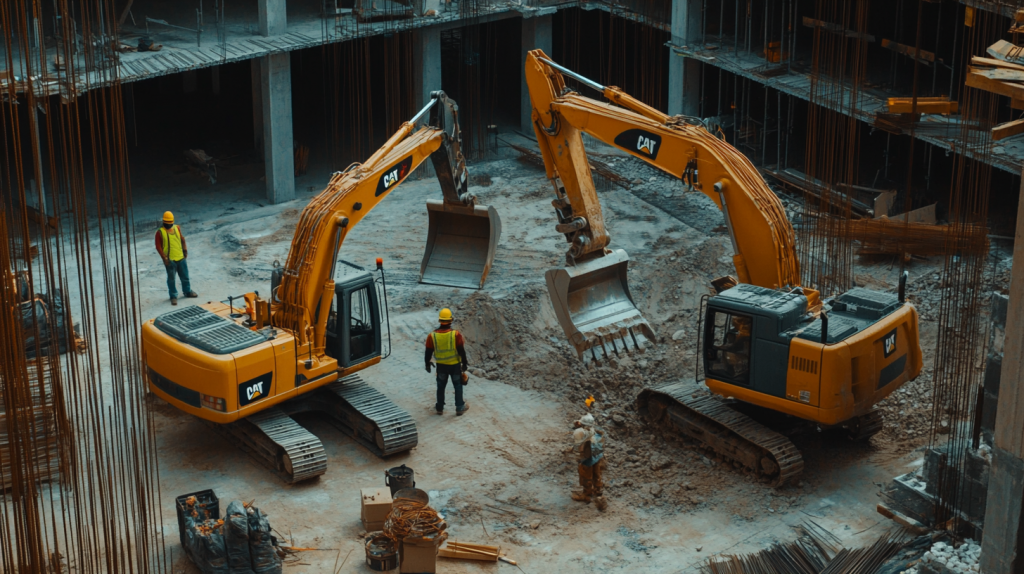
Automation, powered by AI, robotics, and advanced construction management software, is the future of commercial construction. These technologies offer construction companies the ability to work smarter, reduce project timelines, enhance safety, and control costs. As construction automation continues to advance, those who embrace it will be better equipped to meet the demands of modern commercial projects and stay competitive in an ever-evolving industry.
By strategically implementing automation and focusing on continuous improvement, construction companies can maximize the benefits of these powerful tools and position themselves for long-term success in an increasingly digital world.
StruxHub is redefining construction management with innovative solutions tailored for today’s commercial construction needs. With a suite of powerful tools, StruxHub simplifies complex tasks like delivery coordination, document control, and schedule optimization, enabling project managers and field teams to stay aligned and efficient from start to finish.
One of StruxHub’s standout features is its Deliveries Management system, designed to streamline the entire process of managing construction site deliveries. From scheduling to real-time tracking, our platform keeps teams informed of every delivery’s status, ensuring that materials arrive just when needed to prevent costly delays and bottlenecks. By offering visibility and seamless communication, StruxHub’s Deliveries feature not only helps manage logistics but also strengthens collaboration among suppliers, contractors, and site supervisors.
For project leaders looking to optimize planning, Schedule Management is essential. StruxHub’s scheduling tools offer a centralized view of all project tasks, milestones, and resource allocations, making it easy to adjust timelines and allocate resources efficiently. With integrated scheduling, project managers can avoid the common pitfall of overlapping tasks, ensuring that each phase of construction proceeds smoothly. StruxHub’s Schedule feature also provides real-time updates, so teams can respond quickly to changes and stay on track.
Document control and compliance are simplified through StruxHub’s Forms and Documentation feature, which offers easy access to all essential project forms and records. This tool eliminates the hassle of paper documents, ensuring that all records are stored securely and accessible to those who need them. The Forms feature also includes built-in compliance tracking, so teams can meet regulatory requirements with confidence and avoid potential penalties.
Additionally, StruxHub’s Product Overview showcases our comprehensive suite of tools, giving users a detailed look at each feature’s functionality and how it integrates seamlessly with other systems on-site. From enhanced safety tracking to time-saving automation, StruxHub’s platform has been designed to meet the evolving demands of the construction industry. For a more in-depth look at each solution, our Products Page provides a complete breakdown of how StruxHub can support your project goals.
By integrating these tools, StruxHub offers a complete solution that supports project efficiency, enhances team communication, and reduces the risks of unexpected setbacks. Whether you’re focused on optimizing deliveries, streamlining documentation, or keeping your project on schedule, StruxHub’s suite of tools provides the robust support you need. Explore StruxHub’s advanced solutions to experience firsthand how these tools make complex project management tasks easier, keeping your team aligned, informed, and one step ahead.
Unlock the Full Potential of Your Construction Projects with StruxHub
StruxHub enhances efficiency and coordination across all project phases, providing a single source of truth that eliminates silos and fosters collaboration. Real-time updates, financial management tools, and seamless commvunication features ensure that all team members and stakeholders are aligned and informed, reducing the risk of errors and delays. With comprehensive solutions for document management, risk mitigation, and quality control, StruxHub maintains project integrity and safety, while mobile access and integration capabilities further enhance project flexibility and efficiency.
StruxHub’s Key Features and Benefits:
- Advanced Delivery Management: Automate and optimize your delivery schedules, ensuring materials arrive just in time, every time.
- Site Communication: Utilize georeferenced maps and instant messaging to keep every team member informed and aligned.
- Construction Materials Management: Track inventory levels and manage materials procurement with ease, reducing waste and avoiding project delays.
- Construction Safety & Inspection Workflows: Implement customizable mobile forms for conducting safety inspections and managing compliance documentation effortlessly.
- Short-Term Scheduling: Visualize project tasks with detailed floor plans, linking each activity to specific locations for better planning accuracy.
- Construction Resource Management: Efficiently allocate personnel and equipment, maximizing productivity and reducing idle time.
StruxHub’s Product Offering:
- StruxHub Deliveries: Simplifies the coordination of incoming deliveries, ensuring materials and equipment are precisely timed to project needs.
- StruxHub Logistics: Offers intelligent site logistics planning, from crane scheduling to space allocation, for smoother operations.
- StruxHub Safety: Elevates on-site safety standards with easy-to-use tools for inspections, permits, and incident reporting.
- StruxHub Scheduling: Enhances project timelines with intuitive scheduling tools that ensure tasks are completed efficiently and on time.
With StruxHub, construction companies can look forward to a streamlined, more efficient project execution that delivers on time and within budget. Embrace the power of innovation and take your construction projects to the next level.
Don’t miss out on the opportunity to optimize your construction management processes with StruxHub. Sign up for a free demo today. Let’s build smarter, together.
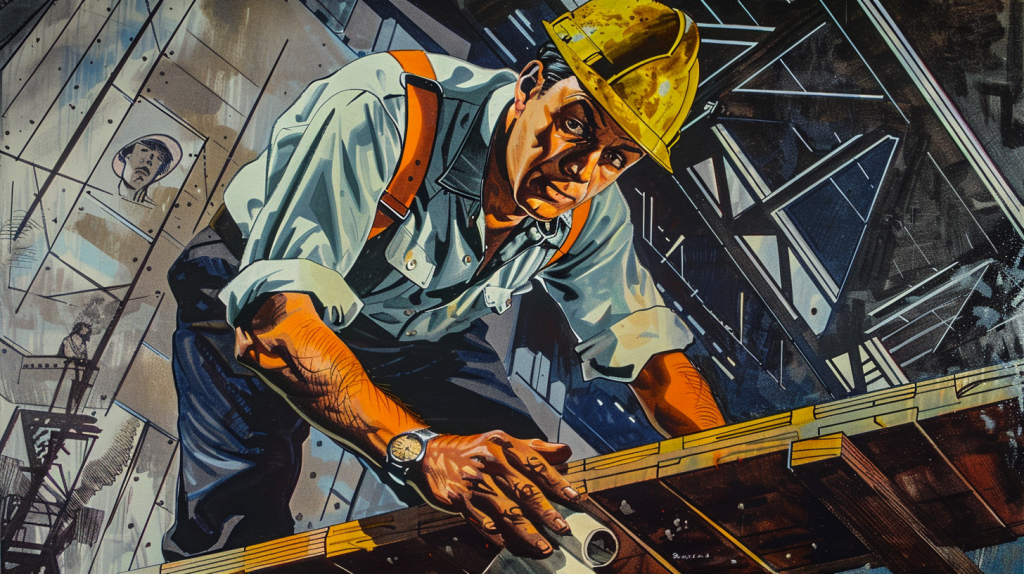
StruxHub: Revolutionizing Project Management in Large Commercial Construction
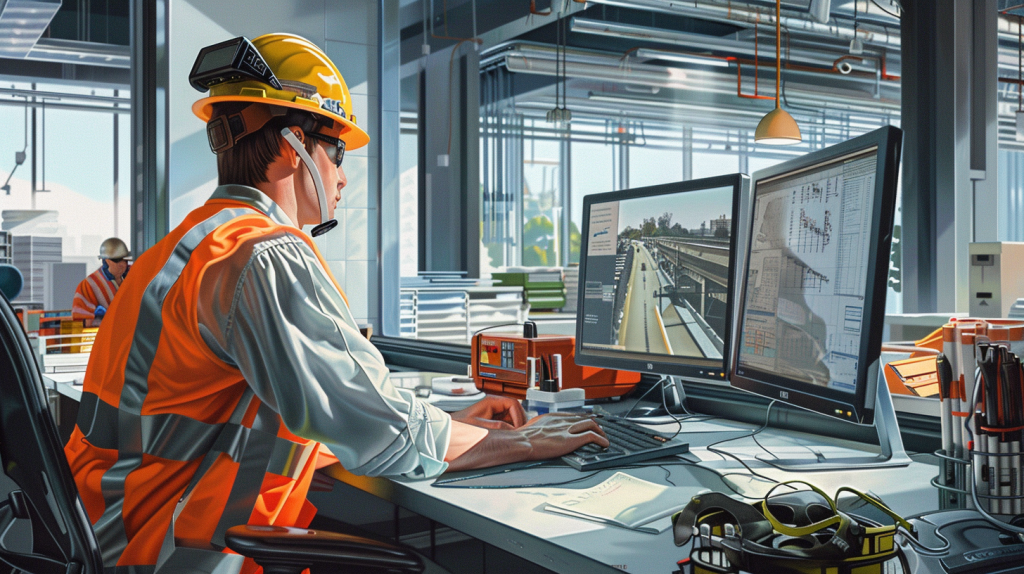
StruxHub
Experience the power of StruxHub today and witness firsthand how it can revolutionize your construction operations.
FAQ’s
1. What is the role of AI in construction automation?
AI plays a critical role in construction automation by optimizing project management, predicting risks, and improving resource allocation. AI algorithms analyze large volumes of data to create precise project schedules, identify potential delays, and recommend solutions to optimize workflow. AI also supports predictive maintenance, monitoring equipment health in real-time to avoid unexpected breakdowns.
In addition, AI is essential for quality control on construction sites. Through real-time analysis of sensor data and imagery, AI can detect issues before they escalate, ensuring that projects meet high standards. These AI-driven insights empower project managers to make data-backed decisions, keeping projects on time and within budget.
AI also enhances communication across teams by centralizing information and automating notifications. By providing up-to-date data to all stakeholders, AI helps reduce miscommunication, which is a common source of delays in construction.
2. How do robotics improve safety on construction sites?
Robotics improve safety by taking over high-risk tasks that would otherwise put human workers in harm’s way. For example, autonomous machines can handle tasks like heavy lifting, excavation, and demolition, which are typically associated with a high risk of injury. Robots are also programmed to follow strict safety protocols, reducing the chance of human error on the job site.
In addition to handling hazardous tasks, robotics support safety monitoring efforts. For example, drones can be deployed to survey potentially dangerous areas, providing real-time insights that help project managers make informed safety decisions. Robotics also allow for remote inspections, reducing the need for workers to enter confined or hazardous spaces.
Wearable robotic devices, such as exoskeletons, enhance worker safety by reducing strain during physically demanding tasks. These devices support workers as they lift heavy materials or work in challenging postures, minimizing the risk of musculoskeletal injuries.
3. What are the benefits of using construction management software with AI and robotics?
Construction management software integrates AI and robotics into a unified platform, allowing project managers to track progress, automate scheduling, and manage resources more effectively. By centralizing data, this software provides a comprehensive view of the entire project, enabling informed decision-making and streamlined communication among teams.
With AI integration, construction management software can automate scheduling and task assignments based on real-time project data, ensuring optimal resource allocation. The software also tracks costs, monitors budgets, and provides forecasts that help keep the project on track financially. This is especially valuable for commercial construction projects where precision and cost control are essential.
The integration of robotics enhances the effectiveness of construction management software by providing real-time data from the job site. Drones and robotic machinery can send updates directly to the software, allowing project managers to monitor site conditions remotely. This connectivity ensures that any changes or issues are addressed promptly, improving efficiency and project outcomes.
4. How does construction automation impact project timelines?
Construction automation significantly shortens project timelines by streamlining processes and reducing downtime. Automated scheduling tools powered by AI ensure that each task is efficiently sequenced, minimizing bottlenecks and maximizing productivity. For instance, AI-based scheduling can predict potential delays, allowing project managers to make adjustments proactively, which keeps the project moving forward without unnecessary interruptions.
Additionally, robotics contribute to faster project completion by handling repetitive or labor-intensive tasks with precision. For example, robotic bricklaying or autonomous concrete pouring can perform tasks at a much faster rate than manual labor while maintaining high accuracy, which reduces rework and keeps the project on schedule. Even on complex commercial projects, automation enables construction companies to handle tasks more efficiently and stay within set timelines.
By integrating automation with real-time tracking software, project managers gain a clear view of project progress. This oversight allows for rapid response to issues as they arise, preventing delays from escalating. The combined efficiency of AI, robotics, and management software ensures that each phase of construction progresses smoothly, reducing the overall time needed to complete a project.
5. What types of tasks are most suitable for automation in construction?
In construction, tasks that are repetitive, labor-intensive, or high-risk are ideal candidates for automation. For example, robots are well-suited for activities like bricklaying, concrete pouring, excavation, and heavy lifting. These tasks not only benefit from the precision and speed of robotics but also reduce physical strain on workers. Automated machinery can work consistently without breaks, which boosts productivity and keeps projects moving at a steady pace.
Drones are also highly effective for aerial site surveys, inspections, and progress tracking. They capture high-resolution images and data from above, offering insights that might be challenging to obtain from the ground. These drones help site managers identify potential issues, such as structural misalignments or safety hazards, allowing for faster adjustments and minimizing delays.
Another task well-suited for automation is predictive maintenance. By using AI to monitor equipment health, construction teams can proactively address maintenance needs, preventing costly breakdowns and equipment downtime. Automating these types of tasks allows workers to focus on more complex and creative aspects of construction, improving overall project efficiency and safety.
6. How do AI and robotics reduce material waste in construction?
AI and robotics help reduce material waste in construction by enhancing precision and optimizing resource usage. AI-powered planning tools analyze data to predict the exact quantity of materials needed, reducing overordering and cutting down on excess. For example, an AI system can take into account historical data from previous projects to provide accurate material estimates based on project specifications, which helps avoid surplus material and keeps costs down.
Robotic machinery contributes to waste reduction by executing tasks with greater accuracy than manual labor. Robotic bricklayers and concrete pourers, for instance, lay materials precisely according to the project design, minimizing errors and eliminating the need for rework. This precision not only improves structural quality but also conserves valuable materials.
AI also supports waste reduction through real-time adjustments in project management software. If a task is modified, AI systems can automatically update material estimates and notify suppliers, helping to prevent excess material orders. Overall, the precise and data-driven nature of AI and robotics in construction leads to more sustainable practices, saving materials and reducing the environmental footprint of each project.

